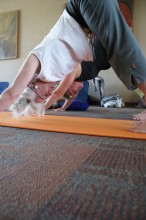
The growing body of research indicates that Yoga helps practitioners to feel physically and emotionally better. Even more so when breathing practices are included. Inversions are part of a complete yoga practice and may be overlooked by some practitioners and/or teachers because of their apparent inaccessibility. However, the key to practicing inversions is to bring the head below the heart. When viewed in this light, there are several inversions that are safe for beginners and have fewer contraindications than headstand, handstand, or shoulderstand.
Ann Brownstone, M.S., O.T.R., uses Yoga to work with those suffering from central nervous system disorders like multiple sclerosis and cerebral palsy, but has also found Yoga postures effective in treating anxiety disorder and depression. In her work with patients suffering from major depressive episode, she has found that a full inversion like headstand, done to the practitioner’s tolerance level and with her assistance, has a positive effect on mood. According to Brownstone, one of the many therapeutic effects of an inverted posture is that it will increase tone and muscle extension in the postural muscles—neck, trunk, and limb girdle muscles responsible for erect carriage against the pull of gravity. In other words, the practice of inversions supports our standing posture—the spine is straighter and the head is in alignment with the spine—when we are upright. Mood is enhanced during and after inverted postures, Brownstone speculates, partly because an inversion challenges the sufferer’s posture and muscle tone—think of the slumped shoulders of chronic depression. Our feelings show up in our posture, so addressing the “muscular” can have a profound effect on mood. In more scientific terms, Brownstone says that the increased extensor tone in the spine has a positive effect on the limbic cortex (emotional centers) and frontal cortical functioning in the brain.
There are enormous physiological benefits in the practice of inversions that lead to a general relaxation response. The gravitational stimulation of the carotid sinus, for example, causes the carotid sinus “to send messages to the medulla of the brain and cardiac centers that ultimately lower heart rate, respiration, and resting blood pressure.”
Karen Koffler, M.D., director of Integrative Medicine at Evanston Northwestern Hospital, says:
“inverted positions that are assumed in Yoga alter the blood flow (including lymphatic drainage) and flow of cerebral spinal fluid (CSF). If there is increased blood flow to the area, there will be increased bioavailability of oxygen and glucose—the two most important metabolic substrates for the brain. It follows then that those cells bathed in a solution that is rich in the building blocks required for the creation of neurotransmitters (like norepinephrine, dopamine, and serotonin) will be better able to produce these chemicals. In addition, altering the flow of CSF and in fact, the compression of the caudal (or bottom) portion of the brain may itself improve overall brain function.”
This makes a lot of sense when you consider that the brain is maintained in a rather stagnant state all day with the bottom portion constantly compressed. In fact, this is the theory that underlies craniosacral therapy, in which the therapist manipulates the skull and other areas of the body to improve CSF flow and improve function.
Based on her own experience and the experience of teaching others, author and master Yoga teacher Rama Jyoti Vernon, who has been practicing Yoga for over fifty years, feels that inversions can be beneficial for both anxiety and depression. She makes an important distinction however. “Where we put the pressure on the head will determine the kind of mood shift we get.” In her observation of thousands of students, she feels that pressure placed closer to the front of the head, will lift a depressive attitude, whereas pressure on the crown stabilizes the mood and the emotions. Rama also teaches that the pressure on the crown of the head is key for stimulating the relaxation response, perhaps through the pressure created in the CSF.

Movement:
A supported Downward-facing Dog Pose (Adho Mukha Svanasana) is an excellent posture that stimulates the front of the head and helps alleviate depression.
Mantra:
Inhale for four counts through the nostrils. As you exhale, roll the cooling tones for the chakras together: “Oh, Uuu, ah, A, E, M, NG.” Practice with the mantras three times, and then remain in the pose for another three to six breaths, inhaling for four counts, exhaling for six.
When you release, come down into child pose, with your forehead on the mat. You can support yourself with cushions to make this posture as comfortable as possible. Roll across your brow with the calming tone of “mmmm,” soothing the busy mind.
For pressure at the crown, Headstand (Sirasana) is an excellent posture. I do not recommend that you try this without instruction from a qualified teacher. If you regularly practice headstand, try it with the mantra “ng,” like the end of the word “king.” This will enhance the effect of 7th chakra stimulation.
Because it activates the back brain, Vernon feels that Shoulderstand (Sarvangasana) is very calming. “It’s a neutralizing pose, so whether there is depression or anxiety, it can be beneficial.” It also stimulates the thyroid, so that if the depression is related to hypothyroidism, shoulder stand is especially useful. In some rare cases, the practice of shoulderstand has been indicated in stroke, likely through constriction of the carotid artery. You can practice shoulderstand responsibly by keeping both the back of the head and the neck and shoulders on the floor. This will result in a half-shoulderstand. You can also take a relaxing legs-up-the-wall pose, keeping your entire spine on the floor.
Inversions are generally done toward the end of Yoga practice. For obvious safety reasons, inversions should be learned from a qualified teacher who can teach you the safest way to enter, hold and release an inversion without doing damage to your head, neck, shoulders or back. People with unmedicated high blood pressure should not practice inversions. Yoga teacher and physiologist Roger Cole, PhD, suggests that there are other conditions besides high blood pressure where inversions might be contraindicated. “These include congestive heart failure, elevated intracranial pressure, carotid artery stenosis (i.e., constriction), hiatal hernia (hernia in which part of the stomach protrudes through the esophageal opening of the diaphragm), stroke, neck problems, glaucoma (any of a group of eye diseases characterized by abnormally high intraocular fluid pressure, damaged optic disk, hardening of the eyeball, and partial to complete loss of vision), and detached retina.” In addition, inversions should not be practiced during menstruation, because you want your menses to flow out and down through your body, not back up toward the uterus.
Since it is vital that you learn to practice inverted postures from a qualified teacher, there are no instructions for full inversions here. Because of their many therapeutic benefits for depression, you may want to discuss them with your yoga teacher.
